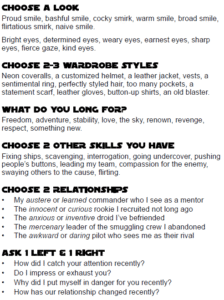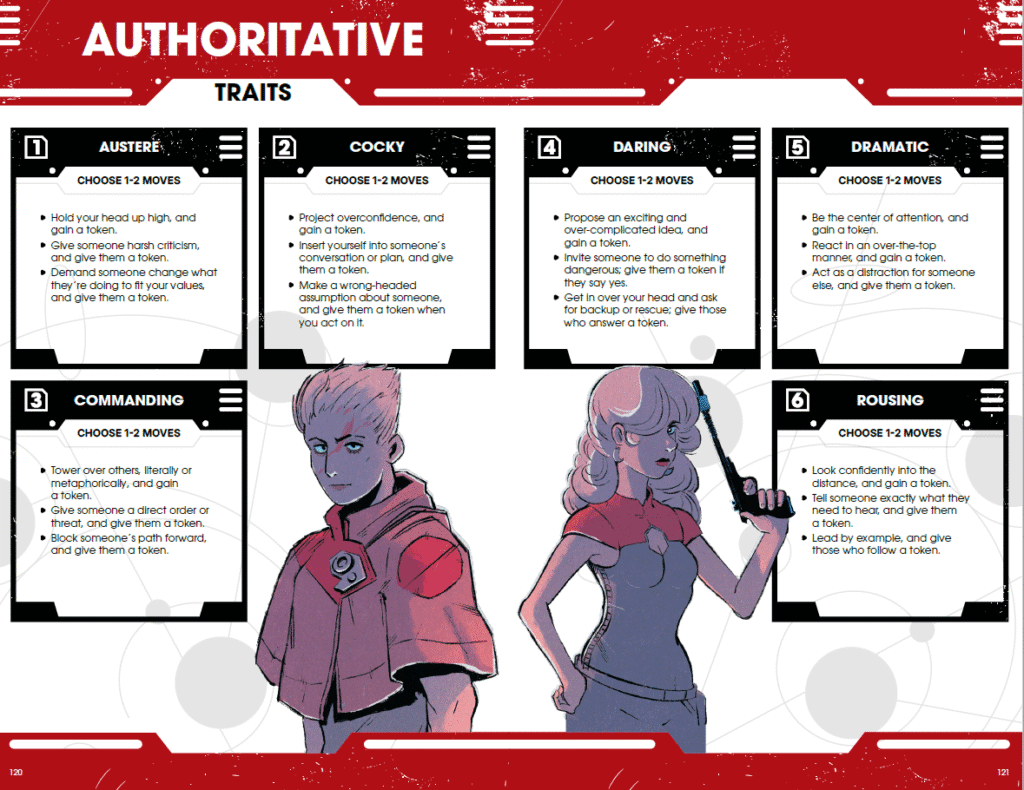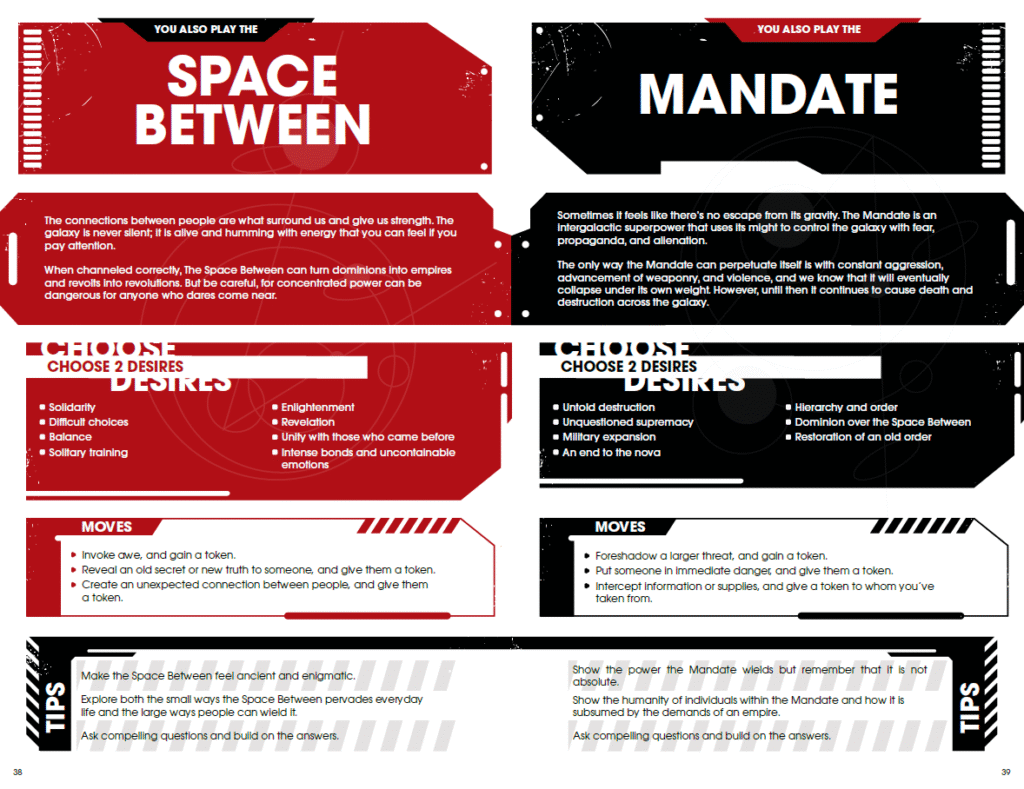I have been a sci fi and Star Wars fan for a looong while. I feel that even if it isn’t as popular as the medieval fantasy genre in TTRPGs, I would dare say it allows you to explore some very different and difficult topics that don’t always resonate as well with other genres. Now, while some issues have started to arise concerning similar games, I was contacted by Jess to see if I was interested in talking about the games she and Riley are Kickstarting together. These are games about rebellion in space, and I have already seen what Jess is capable of in regards to game design so of course I took this opportunity to give a good look at the games and talk about them.
A QUICK NOTE: Jess gave me the games herself, and I do consider her a friend of mine, which may affect my final view of the product. However, if you have stuck with me for a while, you know I always talk about the good, the bad, and what I would have done differently. I don’t write reviews of products I don’t like, still providing feedback to the one who sends me the copy. So, the mere fact that you see this article means that I have good and/or interesting stuff to talk about this game.
A Brief Idea of what Galactic & Going Rogue are
Using the Belonging Outside Belonging system, both of these games completely redefine it to forge a system capable of creating fantastic space dramas filled with action, espionage, criminals, and much more!
Riley’s Galactic goes beyond Belonging Outside Belonging games like the popular Wanderhome by adding Pillars to the story for all players to control. This individual mechanic completely retransforms the game, by making it an entirely GMless TTRPG, with these pillars behaving like sections f the story a GM would control being distributed evenly. I cover this specific aspect in more detail below. However, it is the questions being asked to the players, and the way the pillars behave that give the final shape to Galactic. It creates stories of rebellion in sci-fi outer space, and it excels at that by putting the focus in the characters’ bonds and relationship with each other.
Jess’ Going Rogue was born as an expansion to Galactic that ended up taking a life of its own. In essence, it is Galactic, with a Star Wars theme over it. Jess grabs all the different parties that are essential to create a story on the vein of the Rogue One movie, or the Andor series, and makes them pillars. In addition to that, she adds a twist: the game is to be played as a one-shot, or limited run-campaign (2/3 sessions), ending on a tragic finale for the characters, that will stark hope on future ones, or allow others to fulfill an important mission against the bad guys.
Character Roles
Character Roles are your archetypes, classes. You choose one that best applies to the character you intend to play, and straight out of the book, in a similar vein to other Belonging Outside Belonging, or to name a new one Daggerheart do it, they give you tips on how to create your character to fit the character role, some ideas for looks your character could have, skills, relationships (with NPCs and/or other player characters), and some other more personal questions with possible answers that are tied to the role. On top of that, there are 4 questions for you to choose from, one question for the person sitting on your right, and one for the person sitting on your left.

The image above showcases some of the stuff to choose from for The Ace Character Role in Galactic. I really love seeing more people implementing these tools for character creation because they work as an incredible guideline to help players create a character in a matter of seconds, while also slightly helping the player to play more with the stereotype the character is going for.
Belonging Outside Belonging games wouldn’t be what they are if they didn’t offer their usual moves in the character option to gain or give tokens. This game is no different. You are provided with Strong Moves, Vulnerable Moves, and Lateral Moves, all focusing on things very directly tied to your character role to help you impersonate them better. You can find more info about that, especially if you don’t know this system in particular, in the tokens and moves section:
Tokens and Moves
Belonging Outside Belonging games (sometimes called the No Dice, No Masters engine, created by Avery Alder and Benjamin Rosenbaum) don’t use dice. Instead, they forge a narrative by making use of tokens. For more info on how other games do it, you can check out my flip-through for Cantrip in Youtube, or my article review for Thursday. Essentially, all character options include a series of moves that can be done at any time during the game. Some just are lines that encourage actions for the player to have the character do, while others have offer a mechanical benefit. For Galactic, and consequently Going Rogue as well, Regular Moves with no mechanical interactions are gone, leaving the Strong Moves, the Weak Moves (here named Vulnerable Moves), and the innovative Lateral Moves. In Galactic and Going Rogue, you don’t just use roles for funsies, but they always make a big change in the narrative, helping the story move steps forward in the desired direction.
Strong Moves are actions that have your character be powerful in a way tied to your character role. An Ace may maneuver an unknown vehicle without trouble, while a Spy can vanish without anyone noticing. Despite how good they sound, you can’t spam them all the time because they require you to have a token. How do you get tokens? That’s where the Vulnerable Moves come in, putting your character in a difficult position. Do you, as a player, want your character to do something cool? You will need to “Tell a hard truth in a way that hurts” if you are playing a Diplomat, which is considered a Vulnerable Move, giving you one token. Lastly, the Lateral Moves are prompts for your character to create cool moments with other player characters. If you use a lateral move, you give the player you interact with one of your tokens. Some cool examples are “Ask a player or pillar What can your character share that would make me feel sympathy? and give them a token if they share it” from Going Rogue’s Knight Errant, or “Call in a favor from someone you know, and give them a token.” from the Scoundrel in Galactic.
If you are into narrative games, and are looking to create a very cool and deep story, then games that use the Belonging Outside Belonging are absolutely for you. If you are more into the crunch that games like Pathfinder or D&D offer, however, you may find Galactic and Going Rogue to be a good middle point. From my time playing, gameplay was mostly moving from move to move, with some minimal roleplaying scenes required for the story to make sense (of course, you can always spend an entire hour roleplaying without using a mechanic, but that’s not essential).
Pillars
You might have noticed before that on top of giving tokens to players you can do so to Pillars. But what is a Pillar? Essentially, they are a mechanic that Riley invented for Galactic that brings in the world around the player characters as additional sort of players. You will see this be done on Thursday in the form of “Setting Elements”, as everything that is not the player characters, in the form of something similar to a Character Role to give the players on top of their characters.
The simplicity of the rules of Galactic and Going Rogue allows players to easily be able to track a Character Role AND a Pillar, but other players can also prompt for moves in a pillar another player has to be used. In these games, everyone is the GM, so everyone has access to all the Pillars. They are handed off to singular players so that they can focus more on their own pillar over others. By doing this, a player can easily have their character talk with someone from the “Mandate” pillar by offering the pillar to someone to use the moves in it while in conversation, or during a scene.
The pillars offered in these games are the following:
- The Space Between, outer space, the good, and the bad, and the scary. The awe-inspiring vastness and the connections forged within it.
- The Mandate, the great force that controls the galaxy through propaganda, fear, and constant oppression.
- The Liberation, the everlasting revolution always fighting against The Mandate for a better future for the galaxy
- The Scum & Villany, “ya know, criminals” (literally what it says in the Pillar, which gave me a good chuckle)
On top of these, Going Rogue expands the idea behind Pillars by adding on top of those:
- The Bond, a very special kind of pillar that only one character role has (The Loyal). If you play The Loyal, the bond you have with one specific other player character becomes a pillar of its own.
- The Parliament, the democracy in power at the moment, but that is too slow to act as the real saviors of the story because of politics and wanting to save their own butts and agendas.
- The Intelligence, the clandestine network of spies in the galaxy, often used by The Liberation.
I feel most pillars are really strong, while some may end up fading into the background throughout the stories being told. There is always going to be some pillars more predominant in the story. Having played the game, it was cool seeing how each plays out, and I believe that having them all at sight with ease will prompt pillars to appear every so often into the story. In a way, they act like factions of some sort, and then you have “The Space Between” which is like the environment itself in a way. I feel that last one can be a bit confusing to use, especially for new players.
By having each player take control of one or more pillars, they can track how many tokens the pillar has at all times, and will make them want to exchange tokens with it. It’s a very interesting way of managing external forces in the story which even though I have seen it work properly, I would love to see how their interactions evolve over the length of a campaign.
As a note, Going Rogue (having a whopping 7 pillars total) recommends when playing it to remove the pillars that won’t have much impact in the short story you are planning to tell if needed.
Places
Places are the scenarios in which you make the player characters appear in the game. You are free to transition within scenarios when a scene is over, or stand there for a number of sessions if you see it fit. You are in outer space, in a sci fi story, so you can find pretty much whatever you have in mind. The game offers a list of d66 (You roll a d6, and then another d6 to get the result) locations, categorized as Natural Places, War Places, Crowded Places, Forgotten Places, Liminal Places, and Indimate Places. These all come with details to tie your characters closer to the idea of revolution that the game wants to explore.
Every Place comes with a set of 6 aesthetic elements from which you must choose 2 -3 to locate in the location, and 6 things rumored to be in the location, from which you must choose 2-3 as well. Summed up, these create a total of 35 possible combinations of things for each of those two things. Now make combinations within those two together, and all the different existing places, we are talking about thousands of possible combinations, YAY MATH! So, these number of places should give you plenty of replayability and opportunities for exploration. Very cool! As an example, when trying to create a specific location for my Gone Rogue game, I read through the options in battleground and I was getting all starry eyed with the possibilities of the combinations. THEY WERE ALL GOOD OPTIONS!
Traits
The Traits are characteristics you can give NPCs in the game to make them more unique and alive. Galactic comes with a d66 table, and Gone Rogue adds another 6 to the mix, more leaning towards creating Star Wars stories. Each of these traits come with 3 possible moves, from which you must choose 1 or 2 when giving them to an NPC. As you are always giving more than one trait to an NPC, the choosing within the moves you want to give them makes each NPC feel very distinct.
As a particular note, you will notice that everything in these games provides many options, but they always are 6 of them, or 6 options which each contain 6 other categories. This is in itself clever design for those like myself who likes to roll for everything as in random tables 😀

Group Fates
This is an addition to Gone Rogue that isn’t in Galactic, which makes the creation of a short story with an end we all know will come soon easier to play and run. I find it to be a very elegant design to have players play until they feel that stuff has started to align in a way it makes sense for the story to start its final acts. At any moment in the story, if you notice the game has leaned towards one of the triggers contained within one of the Group Fates, you can decide to have the Group Fate begin, tying the destiny of the character into one kind of cinematic and spectacular finale. Does this mean you enter a railroad until the end? Absolutely not! The chosen fate brings in some additional moves, which make the story lean towards the direction you choose. However, even though you know the story ends in a “Sacrifice”, you don’t fully know how it occurs, so the interesting part becomes playing it out. The moves from the Group Fate can be used as many times as needed until each player is forced to choose within one of the two finishing moves, which put an end to their character story, ending in a tragic way.
To end this section, I will leave an example in the text that perfectly illustrate why I consider this to be amazing design, followed by the thoughts Jess personally told me she had when creating this group fates section.

The group fates are intended to be tragic, yes, but also, cathartic. The act of sacrifice is supposed to be a moment in which you feel, vicariously, through your character, the absolute certainty that something will make such a difference in the world that it is worth giving your life. and yes, that’s tragic, but more than anything, i find that hopeful.
— Jess Levine
Layout and Art
Both creators are still working in full fledged art and layout for their games. The versions I was offered were simple, only text copies that you can already find in Itch: Galactic and Going Rogue. I can not say much about these in that case. However, if you take a look at the images shown in the Kickstarter, you will notice very stylized sci-fi looking layout designs, and beautiful art. If you are a sci-fi fan I don’t think you will get disappointed by any of the two.

A little bit of what you can expect from the game
Jess got me to play one session of Gone Rogue when I asked her for it so I can have a better idea of the game I was going to be reviewing. I was in a rush, and so, within character creation, and a full play, we did 2 hours and 40 mins, one hour of which we used for character creation, assigning the pillars, choosing places, creating NPCs, and learning the rules. So all in all we had 1 hour and 40 mins of playtime. Still, the game worked amazingly! I am super intrigued on how an entire game session looks like.
In my game experience, we were three players, playing as the Liberation in a base of Hoth. I was incredibly excited to sort of have the Darth Vader invading the rebel base at the beginning of Episode V sort of scenario happens after I read through the Places, and the other players agreed. We were playing a veteran scarred Knight Errant, a ghost Spy, and a just-joined rookie Convert. We ditched some pillars we knew we were not going to use because we didn’t create NPCs in them. We created “Imperator Terra Prax”, the leader from the Mandate operation sent to eradicate us with a whole squad.
During the start of it, my character the Convert found out one of the Mandate soldiers was a friend from her past, who she never saw again. These created some exchanges and doubts about who was right in the war going on. The Knight Errant came in for help, and managed to get out of the soldier that the Mandate are creating a droid capable of reading minds to extract information forcefully. Meanwhile we had the Spy in another room being told by a member of the Intelligence that unbeknownst to us, we had a secret from the Mandate brought over in our last raid, and that we needed to protect it at all costs, sacrificing allies if needed. The Spy immediately went to get the intel, but that’s when Imperator Terra Prax surprised her in the room, followed by three soldiers, and one early copy of the mind reading droid. I made use of The Mandate pillar to control this baddie, immobilizing the Spy, and towering over her. Having her mind read could compromise the whole operation.
The Knight Errant aims his sniper shot from afar and makes the liquid nitrogen tank where the Spy is leak, allowing my Convert character to come in and using close quarters combat techniques immobilizing the soldiers, giving the Spy an escape route. While running, the Spy, who had always looked the Convert down, started to see her with other eyes, and revealed what was going on, and the sacrifices that will have to be taken. A dilemma ensues due to what really means to be part of the Liberation: saving all, or making the needed sacrifices, coming from two characters with very different viewpoints and years of experience.
Lastly, we manage to leak the information of this secret mind-reading weapon the Mandate was creating. Our characters stand their ground knowing they have succeeded their mission, giving the Liberation a chance to continue the fight, even if we fade to black to their tragic ends.
Damn that was quite a fulfilling finale. And again… that was an expedited play! I can’t wait to get a whole full session, or a campaign of Galactic going to see the full picture!
Conclusion
All in all, I believe these two games are incredible to create complex no-GM-needed stories of rebellion against oppressing forces, exploring relationships within those taking part in it, the scars, drama, and trauma they leave, and how it affects everyone. It is cathartic, and allows for brilliant storytelling sprawling easily due to how the tokens rotate within each player. While I can see some aspects of the Pillars could be stronger, or some pillars easier to fully comprehend (looking at you Space Between), at the same time I feel they could work well as pillars. I may just need to see it in action, I think these two games can easily become favorites for those looking for an Andor-like story.
The games are being revised now to be relaunched as part of a crowdfunding campaign that is entering its last few days and is already FUNDED. Be sure to check them out and get the other games being offered as part of the Tiers:
Read more at this site

